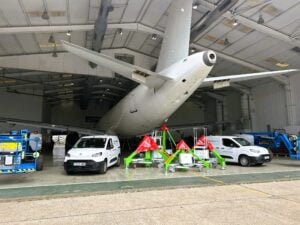During their lifecycle, aircraft are subjected to numerous physical stresses, from weathering hailstorms and bird strikes to ground handling incidents. The consequences are that an aircraft fuselage can suffer from dents, buckles and minor structural damage. In general terms these minor structural defects do not affect the structural integrity of the aircraft, however precise documentation of such ‘imperfections’ is essential to guarantee its continued airworthiness and safety.
We will delve much deeper into not just the purpose of what is referred to as a ‘dent and buckle chart’, an essential tool for the effective maintenance of aircraft, but also best practices for managing dent and buckle charts, a cornerstone of effective structural monitoring.
What are Dent and Buckle Charts?
A dent and buckle chart is an ongoing and historic, comprehensive, detailed record of all structural imperfections identified on an aircraft. The details provided in these charts will include the location of the imperfection, usually by means of a grid reference system. The size and depth of any imperfection, including its diameter and depth, are also recorded as a means of helping to determine the extent of the damage.
The imperfection will also be assessed for its ‘acceptability’ based on manufacturer’s guidelines for permissible limits and whether it will subsequently need to be repaired. Because a dent and buckle chart is a continuous record of events affecting a particular aircraft, over time you will end up with a ‘living document’ which will continue to evolve over an aircraft’s lifetime, showing that all structural issues have been tracked, assessed and where appropriate, repaired.
What is the Importance of a Dent and Buckle Chart?
The principal role of a dent and buckle chart is to ensure an aircraft’s airworthiness. Even minor structural imperfections can compromise an aircraft’s integrity if left unchecked. By maintaining accurate records, technicians can monitor changes over time, making sure they remain within safe limits. A dent and buckle chart is also a key element of the documentation required to be kept as proof of compliance required during inspections and audits as aviation authorities such as the FAA and EASA require airlines and maintenance organisations to document and manage any structural damage.
A dent and buckle chart also tends to help with cost management. This is principally because minor defects can be dealt with at the appropriate time, rather than being allowed to develop into something more serious, and costly, resulting in easily avoidable downtime. Last, but by no means least, a comprehensive and up-to-date dent and buckle chart will help an aircraft to maintain its maximum value. The chart is a means of providing transparency about its structural history, thus helping to increase buyer confidence.
What are the Best Practices for Maintaining a Dent and Buckle Chart?
To begin with it is vital that inspections are thorough and consistent. Consequently, technicians will need to be trained to both identify any damage to an aircraft using such equipment as a depth gauge and borescope, and also how to correctly document that damage. Where record keeping is concerned, it is vital to adopt a clear and standardised template for dent and buckle charts. This makes it easier for different teams and regulatory authorities to understand and interpret the data.
With constant advances in technology, thanks to modern maintenance management systems (MMSs), dent and buckle charts are now digitised. The main advantages of this are that digitised records are easier to keep up to date, information is more easily accessed across multiple hubs, and digital records are also integrated within predictive maintenance systems.
As previously mentioned, the dent and buckle chart is a historic record of every structural defect found on an aircraft over time. That record of defects also includes a note of each and every inspection made. This means that after every scheduled or unscheduled maintenance check, the chart must be reviewed and updated. New findings should be logged, and any existing damage re-evaluated for any changes.
In many instances, in their Aircraft Maintenance Manuals (AMMs) manufacturers like Boeing and Airbus provide detailed limits for acceptable dents and buckles. Technicians should always consult these guidelines before deciding on whether repairs to any damage are required, or if it can safely be deferred.
If the identified damage to an aircraft exceeds allowable limits, then it is vital that repairs are immediately instigated and coordinated to minimise downtime and ensure that no further damage is caused to the aircraft. Once the repairs required have been documented, the work should be carried out and the repairs recorded on the dent and buckle chart, together with a post-repair status update.
Finally, it is important to ensure that all maintenance staff and technicians are regularly trained and updated with the latest techniques, tools and regulatory requirements and that dent and buckle charts are managed accordingly.
What Are the Most common Challenges Facing the Maintenance of Dent and Buckle Charts?
To begin with there is the problem of inconsistent documentation where, without standardised processes, records can become incomplete or difficult to interpret, potentially leading to oversights. Then there is human error, something that is very difficult to eradicate completely. Consequently, mismeasurements or failure to update charts after inspections can compromise accuracy. While lack of transparency and sharing of data can lead to discrepancies. Thus, dent and buckle charts should be maintained neither manually, nor locally as this will hinder information sharing between maintenance hubs.
Finally, there is the problem of hard-to-reach areas on an aircraft where it can be difficult to identify any damage without very close inspection. Fortunately, that problem has been alleviated to a degree with the introduction of new inspection techniques and tools, such as drones or robotic systems.
What Are the Recent Innovations in Dent and Buckle Management?
There have been a considerable number of advancements in modern technology which have had a tremendously positive impact on how dent and buckle charts are effectively maintained. A prime example of this is the introduction of drones with high-resolution cameras for inspections. Drones equipped with high-resolution cameras can more efficiently and accurately capture detailed images of dents and buckles, even in hard-to-reach areas. When combined with the power of AI this has become something of a game changer. AI tools can analyse images of structural damage to provide precise measurements and suggest classification based on regulatory standards.
We then have the use of 3-D modelling. Here, digital twins and 3-D mapping tools enable a detailed visual representation of an aircraft’s structural condition, seamlessly integrating dent and buckle data. Finally, we have blockchain for records where blockchain technology ensures secure, tamper-proof documentation of maintenance history, adding trust and transparency.
To conclude, maintaining dent and buckle charts is an essential part of aircraft maintenance, safeguarding structural integrity and operational safety. By adopting best practices and leveraging modern technologies, airlines, owners and MROs can all ensure these records are accurate, accessible, and actionable. As the aviation industry continues to evolve, robust dent and buckle charts will remain a vital tool for the safe and effective maintenance of aircraft.































